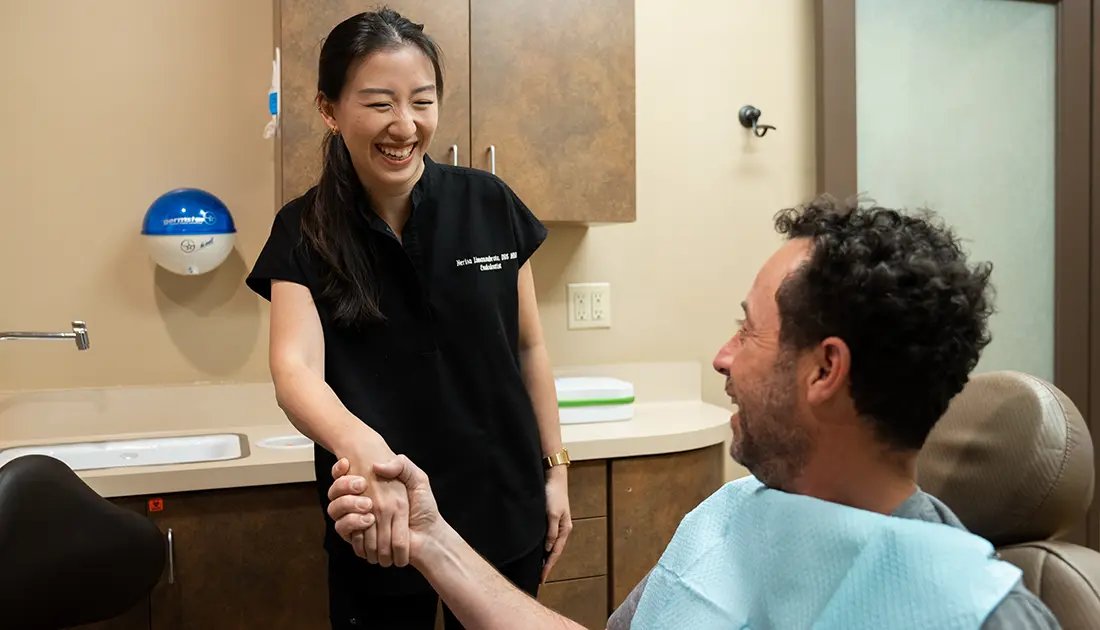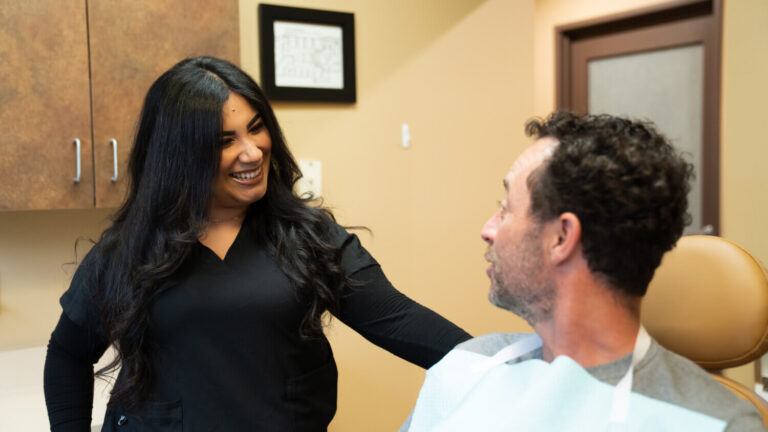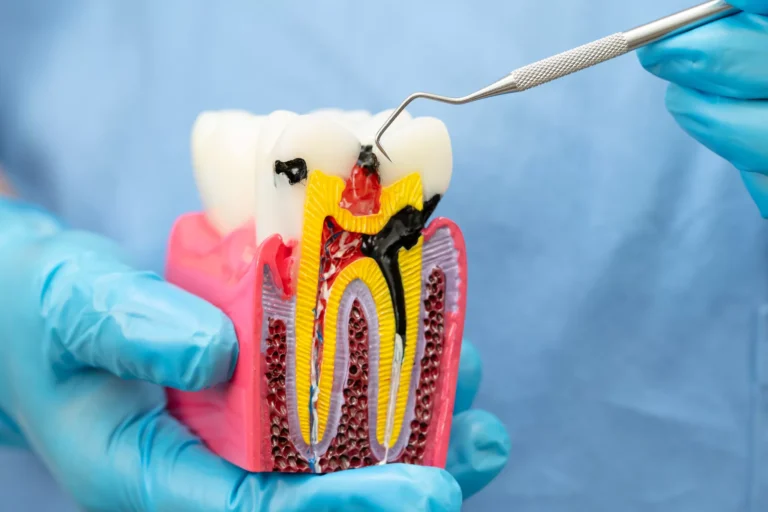At Foundation Dental Specialists, we guarantee our patients quick, efficient, and less painful root canal treatment that will prevent the spread of infection and save their natural teeth.
Toothaches are painful and can distract you from living your best life. They can also be a sign of a serious infection. Fortunately, root canal therapy can provide you with the relief you need, and with modern techniques, you will be kept comfortable during the procedure. Root canals can help restore the health of your tooth, and save you from a tooth extraction down the road.
Don’t let a toothache hold you back from enjoying life. Contact Foundation Dental Specialists today to schedule a consultation and explore the benefits of root canal therapy!

No one plans to have a dental emergency, and that’s why we offer emergency dental exams, so you don’t need to wait to get the care you need to relieve your dental pain.
Root canal therapy is a commonly performed dental procedure to save a damaged or decayed tooth. At Foundation Dental Specialists, we offer comprehensive and personalized endodontic treatments, including root canal therapy, to help patients maintain their oral health. Root canal therapy is often misunderstood and unfairly maligned, but in reality, it is a crucial procedure that can effectively alleviate pain and save a natural tooth from extraction.

If you’re considering a root canal in Pasadena, it’s helpful to understand what to expect. This step-by-step overview explains how we diagnose, treat, and restore your tooth using advanced methods and a patient-centered approach.



Root canal therapy offers more than just pain relief—it can protect your long-term oral health and prevent serious complications. Below are some of the key reasons why patients in Pasadena choose this treatment.
At Foundation Dental Specialists, we invest in the latest technology to ensure your root canal in Pasadena is precise, efficient, and virtually pain-free. Our tools allow for more accurate diagnoses and less invasive treatment experiences.
Cracked teeth are more than just a cosmetic concern—they can lead to serious oral health problems if left untreated. These cracks make the tooth more vulnerable to infection and structural damage. In many cases, root canal therapy combined with a dental crown can save the tooth, stop the crack from worsening, and restore both strength and function.
Foundation Dental Specialists proudly provides root canal services to patients across Pasadena and nearby communities, including:
If you’re searching for “root canal near me” in any of these areas, our Pasadena dental office is here to help with expert, compassionate care.
If you’re experiencing tooth pain, sensitivity, or swelling, don’t wait—these could be signs of a serious infection. At Foundation Dental Specialists in Pasadena, we provide expert root canal treatment in Pasadena designed to relieve pain, stop infection, and save your smile.
Contact us today to schedule your consultation or to learn more about our full range of endodontic and dental services. We’re here to help residents of Pasadena, Altadena, San Gabriel Valley, Eagle Rock, and Glendale get the relief they need.

Are you experiencing tooth pain or sensitivity? A root canal might be necessary to save your tooth from infection.
Root canal therapy is required if your tooth becomes infected, which most often happens one of two ways:
If left untreated, either situation will lead to the infection, decay, and eventual death of your tooth’s pulp. When the infection starts to take hold, you’ll likely begin experiencing an array of symptoms like a toothache, inflamed gums near the tooth, and tooth sensitivity.
No! Although it’s a common myth that root canal therapy hurts, it’s actually the toothache caused by infection that is painful. With modern dental techniques and technology, a root canal is no more uncomfortable than getting a dental filling.
Not only will your mouth be numbed completely, but you can also opt to be sedated during the procedure. Overall, root canal therapy is the best way to alleviate the pain and discomfort of an infected tooth.
Although it’s rare, root canal treatment can fail. If there is any remaining bacteria or decay left behind that wasn’t removed during the initial root canal, the tooth infection may return. If this happens to you, you may need a retreatment or another approach to root canal therapy, called an Apico surgery, to help rid the tooth of infection.
After root canal treatment, the tooth is no longer “vital” and will become more brittle as a result. The best way to protect the the tooth, especially posterior teeth which take heavier forces, is to have your dentist place a crown on the tooth after your root canal treatment is completed.
Root canal therapy is usually covered, at least in part, by most dental insurance plans. However, it’s always a good idea to get in touch with your insurance provider to gain a thorough understanding of your benefits, and to find out what type of treatments are covered.
Toothaches are painful and can distract you from living your best life. They can also be a sign of a serious infection. Fortunately, root canal therapy can provide you with the relief you need, and with modern techniques, you will be kept comfortable during the procedure. Root canals can help restore the health of your tooth, and save you from a tooth extraction down the road.
Don’t let a toothache hold you back from enjoying life. Contact Foundation Dental Specialists in Pasadena today to schedule a consultation and explore the benefits of root canal therapy!

Root canal therapy is a commonly performed dental procedure to save a damaged or decayed tooth. At Foundation Dental Specialists in Pasadena, we offer comprehensive and personalized endodontic treatments, including root canal therapy, to help patients maintain their oral health. Root canal therapy is often misunderstood and unfairly maligned, but in reality, it is a crucial procedure that can effectively alleviate pain and save a natural tooth from extraction.

For your comfort and peace of mind, we offer a variety of sedation options to ensure your root canal therapy is a pain-free experience.
Advanced digital imaging techniques, such as our high-resolution CBCT scanner, have taken the guesswork out of root canal therapy. This results in a quicker, more efficient procedure with less pain or discomfort than ever before.
At our practice, we take imaging to the next level. With our advanced oral microscopes, we can see a highly detailed view of your tooth's structure, which makes endodontic treatment more effective and less invasive.
Cracked teeth are more susceptible to infection, and are more likely to take on more damage when left untreated. Root canal therapy along with a dental crown can help save and reinforce the affected tooth, and stop the crack from spreading.
No one plans to have a dental emergency, and that’s why we offer emergency dental exams, so you don’t need to wait to get the care you need to relieve your dental pain.
Instantly alleviate your toothache by clearing out any infected or decayed material.
Left untreated, infection can spread to other parts of your mouth, or even cause serious infection in other parts of the body.
Restore the health of your tooth, and avoid the need for a more drastic procedure like an extraction.

To find the source of your dental pain, your endodontist in Pasadena will begin by performing a comprehensive exam and review of your x-rays to get a complete picture of your oral health. A 3D x-ray, called a cone beam CT scan, may be used to assess more challenging cases. If your tooth is infected, your endodontist in Pasadena will determine the extent of the infection to decide if root canal therapy will be an effective treatment. If you end up needing a root canal, your dentist will begin the therapy by numbing the treatment site, all the way down to the nerves. Your endodontist in Pasadena will discuss sedation options with you before starting the procedure.

Once you’re comfortable and fully numbed, your endodontist in Pasadena will begin the process of removing any decayed or infected material. Beginning with the enamel, your endodontist in Pasadena will move inwards, toward the pulp. Once the infected pulp has been cleared out, the canals will be cleaned and the area will be flushed with a special disinfectant to eliminate any remaining infection.

Once your tooth has been completely cleaned and sanitized, the interior will be filled with a rubber-like material called “gutta-percha.” An inert material, gutta-percha replaces the extracted pulp and helps to support the tooth and maintain its structure. Once the interior of the tooth has been filled, it will be restored with either a filling or a dental crown, depending on the extent of the decay, and how much healthy enamel remains.
Are you experiencing tooth pain or sensitivity in Pasadena? A root canal might be necessary to save your tooth from infection.
Root canal therapy is required if your tooth becomes infected, which most often happens one of two ways:
If left untreated, either situation will lead to the infection, decay, and eventual death of your tooth’s pulp. When the infection starts to take hold, you’ll likely begin experiencing an array of symptoms like a toothache, inflamed gums near the tooth, and tooth sensitivity.
No! Although it’s a common myth that root canal therapy hurts, it’s actually the toothache caused by infection that is painful. With modern dental techniques and technology, a root canal is no more uncomfortable than getting a dental filling.
Not only will your mouth be numbed completely, but you can also opt to be sedated during the procedure. Overall, root canal therapy is the best way to alleviate the pain and discomfort of an infected tooth.
Although it’s rare, root canal treatment can fail. If there is any remaining bacteria or decay left behind that wasn’t removed during the initial root canal, the tooth infection may return. If this happens to you, you may need a retreatment or another approach to root canal therapy, called an Apico surgery, to help rid the tooth of infection.
After root canal treatment, the tooth is no longer “vital” and will become more brittle as a result. The best way to protect the the tooth, especially posterior teeth which take heavier forces, is to have your dentist place a crown on the tooth after your root canal treatment is completed.
Root canal therapy is usually covered, at least in part, by most dental insurance plans. However, it’s always a good idea to get in touch with your insurance provider to gain a thorough understanding of your benefits, and to find out what type of treatments are covered.
Our approach to root canal therapy prioritizes patient comfort and long-term oral health. We understand the anxiety surrounding this procedure and take every measure to ensure a stress-free experience. Our team of expert endodontists utilizes advanced techniques and technology to provide efficient and gentle root canal therapy, offering relief from toothaches and promoting the preservation of natural teeth. With our dedication to comprehensive care and patient well-being, you can trust us to restore your smile and alleviate your discomfort with expertise and compassion.
Our experienced team of Pasadena endodontists has the expertise to provide outstanding root canal therapy Pasadena residents can trust. Our specialists understand the unique dental needs of each patient and use the latest technology to ensure safe and successful outcomes.
At Foundation Dental Specialists, our priority is to reduce dental anxiety and provide comfortable and stress-free root canal therapy to our patients. Our pain management protocol, combined with sedation options offers patients a personalized and comfortable root canal therapy experience.
Root canal treatment Pasadena patients require involves the removal of the tooth’s infected pulp, cleaning, and disinfecting the canal area before filling it to restore its function. We make the process even less invasive but highly effective with the use of high-resolution CBCT scanners and advanced oral microscopes for diagnosis and treatment.
Root canal Pasadena is an effective way of saving a damaged or decayed tooth by removing the infected pulp, thoroughly cleaning the canal area, and restoring the tooth’s function. At Foundation Dental Specialists, we guarantee our patients quick, efficient, and less painful root canal treatment that will prevent the spread of infection and save their natural teeth.
While root canal therapy is highly effective in saving damaged teeth, endodontic microsurgery in Pasadena may be recommended for complicated root canal challenges. It is a minimally invasive surgical procedure that aims to remove any residual infected tissues and rid the tooth of the infection.
Our team of specialists at Foundation Dental Specialists is highly experienced in performing the delicate endodontic microsurgery Pasadena residents may require. Patients can opt for this advanced surgical procedure if a previous root canal therapy fails or a cracked tooth is detected.
Whether it’s root canal therapy, endodontic microsurgery, or any other endodontic procedures, Foundation Dental Specialists in Pasadena is renowned for providing top-quality, personalized, and compassionate dental treatments to patients. Our advanced technology and experienced team of specialists guarantee that your every dental need is met efficiently, quickly, and with minimal discomfort. Call us today at (626) 796-5361 to schedule a consultation.